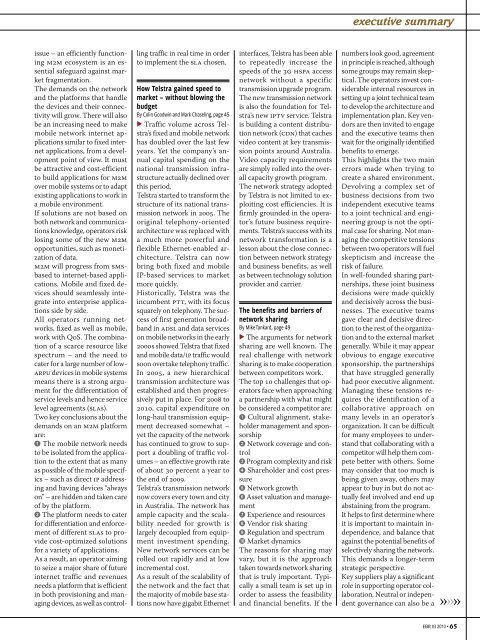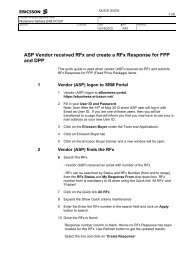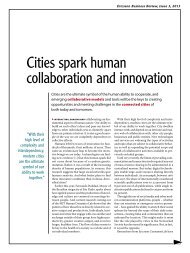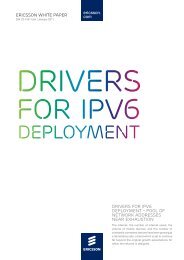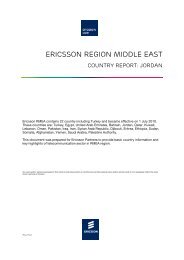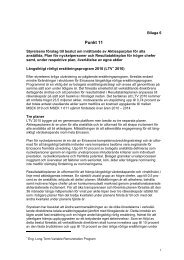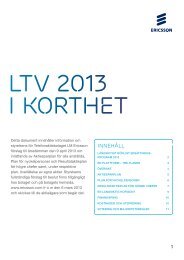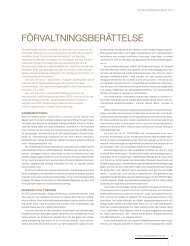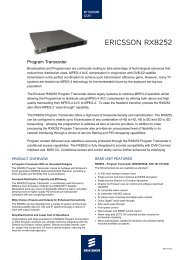Telenor's - Ericsson
Telenor's - Ericsson
Telenor's - Ericsson
- TAGS
- ericsson
- www.ericsson.com
Create successful ePaper yourself
Turn your PDF publications into a flip-book with our unique Google optimized e-Paper software.
issue – an efficiently functioning<br />
m2m ecosystem is an essential<br />
safeguard against market<br />
fragmentation.<br />
The demands on the network<br />
and the platforms that handle<br />
the devices and their connectivity<br />
will grow. There will also<br />
be an increasing need to make<br />
mobile network internet applications<br />
similar to fixed internet<br />
applications, from a development<br />
point of view. It must<br />
be attractive and cost-efficient<br />
to build applications for m2m<br />
over mobile systems or to adapt<br />
existing applications to work in<br />
a mobile environment.<br />
If solutions are not based on<br />
both network and communications<br />
knowledge, operators risk<br />
losing some of the new m2m<br />
opportunities, such as monetization<br />
of data.<br />
m2m will progress from smsbased<br />
to internet-based applications.<br />
Mobile and fixed devices<br />
should seamlessly integrate<br />
into enterprise applications<br />
side by side.<br />
All operators running networks,<br />
fixed as well as mobile,<br />
work with QoS. The combination<br />
of a scarce resource like<br />
spectrum – and the need to<br />
cater for a large number of lowarpu<br />
devices in mobile systems<br />
means there is a strong argument<br />
for the differentiation of<br />
service levels and hence service<br />
level agreements (slas).<br />
Two key conclusions about the<br />
demands on an m2m platform<br />
are:<br />
� The mobile network needs<br />
to be isolated from the application<br />
to the extent that as many<br />
as possible of the mobile specifics<br />
– such as direct ip addressing<br />
and having devices “always<br />
on” – are hidden and taken care<br />
of by the platform.<br />
� The platform needs to cater<br />
for differentiation and enforcement<br />
of different slas to provide<br />
cost-optimized solutions<br />
for a variety of applications.<br />
As a result, an operator aiming<br />
to seize a major share of future<br />
internet traffic and revenues<br />
needs a platform that is efficient<br />
in both provisioning and managing<br />
devices, as well as control-<br />
ling traffic in real time in order<br />
to implement the sla chosen.<br />
How Telstra gained speed to<br />
market – without blowing the<br />
budget<br />
By Colin Goodwin and Mark Chaseling, page 45<br />
▶ Traffic volume across Telstra’s<br />
fixed and mobile network<br />
has doubled over the last few<br />
years. Yet the company’s annual<br />
capital spending on the<br />
national transmission infrastructure<br />
actually declined over<br />
this period.<br />
Telstra started to transform the<br />
structure of its national transmission<br />
network in 2005. The<br />
original telephony-oriented<br />
architecture was replaced with<br />
a much more powerful and<br />
flexible Ethernet-enabled architecture.<br />
Telstra can now<br />
bring both fixed and mobile<br />
IP-based services to market<br />
more quickly.<br />
Historically, Telstra was the<br />
incumbent ptt, with its focus<br />
squarely on telephony. The success<br />
of first generation broadband<br />
in adsl and data services<br />
on mobile networks in the early<br />
2000s showed Telstra that fixed<br />
and mobile data/ip traffic would<br />
soon overtake telephony traffic.<br />
In 2005, a new hierarchical<br />
transmission architecture was<br />
established and then progressively<br />
put in place. For 2008 to<br />
2010, capital expenditure on<br />
long-haul transmission equipment<br />
decreased somewhat –<br />
yet the capacity of the network<br />
has continued to grow to support<br />
a doubling of traffic volumes<br />
– an effective growth rate<br />
of about 30 percent a year to<br />
the end of 2009.<br />
Telstra’s transmission network<br />
now covers every town and city<br />
in Australia. The network has<br />
ample capacity and the scalability<br />
needed for growth is<br />
largely decoupled from equipment<br />
investment spending.<br />
New network services can be<br />
rolled out rapidly and at low<br />
incremental cost.<br />
As a result of the scalability of<br />
the network and the fact that<br />
the majority of mobile base stations<br />
now have gigabit Ethernet<br />
interfaces, Telstra has been able<br />
to repeatedly increase the<br />
speeds of the 3g hspa access<br />
network without a specific<br />
transmission upgrade program.<br />
The new transmission network<br />
is also the foundation for Telstra’s<br />
new iptv service. Telstra<br />
is building a content distribution<br />
network (cdn) that caches<br />
video content at key transmission<br />
points around Australia.<br />
Video capacity requirements<br />
are simply rolled into the overall<br />
capacity growth program.<br />
The network strategy adopted<br />
by Telstra is not limited to exploiting<br />
cost efficiencies. It is<br />
firmly grounded in the operator’s<br />
future business requirements.<br />
Telstra’s success with its<br />
network transformation is a<br />
lesson about the close connection<br />
between network strategy<br />
and business benefits, as well<br />
as between technology solution<br />
provider and carrier.<br />
The benefi ts and barriers of<br />
network sharing<br />
By Mike Tankard, page 49<br />
▶ The arguments for network<br />
sharing are well known. The<br />
real challenge with network<br />
sharing is to make cooperation<br />
between competitors work.<br />
The top 10 challenges that operators<br />
face when approaching<br />
a partnership with what might<br />
be considered a competitor are:<br />
� Cultural alignment, stakeholder<br />
management and sponsorship<br />
� Network coverage and control<br />
� Program complexity and risk<br />
� Shareholder and cost pressure<br />
� Network growth<br />
� Asset valuation and management<br />
� Experience and resources<br />
� Vendor risk sharing<br />
� Regulation and spectrum<br />
� Market dynamics<br />
The reasons for sharing may<br />
vary, but it is the approach<br />
taken towards network sharing<br />
that is truly important. Typically<br />
a small team is set up in<br />
order to assess the feasibility<br />
and financial benefits. If the<br />
executive summary<br />
numbers look good, agreement<br />
in principle is reached, although<br />
some groups may remain skeptical.<br />
The operators invest considerable<br />
internal resources in<br />
setting up a joint technical team<br />
to develop the architecture and<br />
implementation plan. Key vendors<br />
are then invited to engage<br />
and the executive teams then<br />
wait for the originally identified<br />
benefits to emerge.<br />
This highlights the two main<br />
errors made when trying to<br />
create a shared environment.<br />
Devolving a complex set of<br />
business decisions from two<br />
independent executive teams<br />
to a joint technical and engineering<br />
group is not the optimal<br />
case for sharing. Not managing<br />
the competitive tensions<br />
between two operators will fuel<br />
skepticism and increase the<br />
risk of failure.<br />
In well-founded sharing partnerships,<br />
these joint business<br />
decisions were made quickly<br />
and decisively across the businesses.<br />
The executive teams<br />
gave clear and decisive direction<br />
to the rest of the organization<br />
and to the external market<br />
generally. While it may appear<br />
obvious to engage executive<br />
sponsorship, the partnerships<br />
that have struggled generally<br />
had poor executive alignment.<br />
Managing these tensions requires<br />
the identification of a<br />
collaborative approach on<br />
many levels in an operator’s<br />
organization. It can be difficult<br />
for many employees to understand<br />
that collaborating with a<br />
competitor will help them compete<br />
better with others. Some<br />
may consider that too much is<br />
being given away, others may<br />
appear to buy in but do not actually<br />
feel involved and end up<br />
abstaining from the program.<br />
It helps to first determine where<br />
it is important to maintain independence,<br />
and balance that<br />
against the potential benefits of<br />
selectively sharing the network.<br />
This demands a longer-term<br />
strategic perspective.<br />
Key suppliers play a significant<br />
role in supporting operator collaboration.<br />
Neutral or independent<br />
governance can also be a »»»<br />
EBR #3 2010 65


